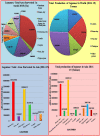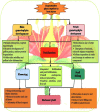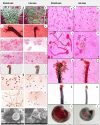Food Legumes and Rising Temperatures: Effects, Adaptive Functional Mechanisms Specific to Reproductive Growth Stage and Strategies to Improve Heat Tolerance
- PMID: 29123532
- PMCID: PMC5662899
- DOI: 10.3389/fpls.2017.01658
Food Legumes and Rising Temperatures: Effects, Adaptive Functional Mechanisms Specific to Reproductive Growth Stage and Strategies to Improve Heat Tolerance
Abstract
Ambient temperatures are predicted to rise in the future owing to several reasons associated with global climate changes. These temperature increases can result in heat stress- a severe threat to crop production in most countries. Legumes are well-known for their impact on agricultural sustainability as well as their nutritional and health benefits. Heat stress imposes challenges for legume crops and has deleterious effects on the morphology, physiology, and reproductive growth of plants. High-temperature stress at the time of the reproductive stage is becoming a severe limitation for production of grain legumes as their cultivation expands to warmer environments and temperature variability increases due to climate change. The reproductive period is vital in the life cycle of all plants and is susceptible to high-temperature stress as various metabolic processes are adversely impacted during this phase, which reduces crop yield. Food legumes exposed to high-temperature stress during reproduction show flower abortion, pollen and ovule infertility, impaired fertilization, and reduced seed filling, leading to smaller seeds and poor yields. Through various breeding techniques, heat tolerance in major legumes can be enhanced to improve performance in the field. Omics approaches unravel different mechanisms underlying thermotolerance, which is imperative to understand the processes of molecular responses toward high-temperature stress.
Keywords: food legumes; functional mechanisms; high temperature stress; reproductive function; ‘Omics’ approach.
Figures





Similar articles
-
Identification and Characterization of Contrasting Genotypes/Cultivars for Developing Heat Tolerance in Agricultural Crops: Current Status and Prospects.Front Plant Sci. 2020 Oct 22;11:587264. doi: 10.3389/fpls.2020.587264. eCollection 2020. Front Plant Sci. 2020. PMID: 33193540 Free PMC article. Review.
-
Physiological and Molecular Approaches for Developing Thermotolerance in Vegetable Crops: A Growth, Yield and Sustenance Perspective.Front Plant Sci. 2022 Jun 28;13:878498. doi: 10.3389/fpls.2022.878498. eCollection 2022. Front Plant Sci. 2022. PMID: 35837452 Free PMC article.
-
Hormonal regulation of reproductive growth under normal and heat-stress conditions in legume and other model crop species.J Exp Bot. 2017 Apr 1;68(8):1885-1894. doi: 10.1093/jxb/erw464. J Exp Bot. 2017. PMID: 28011717 Review.
-
Effects, tolerance mechanisms and management of salt stress in grain legumes.Plant Physiol Biochem. 2017 Sep;118:199-217. doi: 10.1016/j.plaphy.2017.06.020. Epub 2017 Jun 16. Plant Physiol Biochem. 2017. PMID: 28648997 Review.
-
Heat stress response mechanisms in pollen development.New Phytol. 2021 Jul;231(2):571-585. doi: 10.1111/nph.17380. Epub 2021 May 20. New Phytol. 2021. PMID: 33818773 Free PMC article. Review.
Cited by
-
Drought and heat stress: insights into tolerance mechanisms and breeding strategies for pigeonpea improvement.Planta. 2024 Apr 15;259(5):123. doi: 10.1007/s00425-024-04401-6. Planta. 2024. PMID: 38622376 Review.
-
Regulation of the regulators: Transcription factors controlling biosynthesis of plant secondary metabolites during biotic stresses and their regulation by miRNAs.Front Plant Sci. 2023 Mar 2;14:1126567. doi: 10.3389/fpls.2023.1126567. eCollection 2023. Front Plant Sci. 2023. PMID: 36938003 Free PMC article. Review.
-
Investigating false start of the main growing season: A case of Uganda in East Africa.Heliyon. 2021 Nov 19;7(11):e08428. doi: 10.1016/j.heliyon.2021.e08428. eCollection 2021 Nov. Heliyon. 2021. PMID: 34901492 Free PMC article.
-
What Did We Learn From Current Progress in Heat Stress Tolerance in Plants? Can Microbes Be a Solution?Front Plant Sci. 2022 May 23;13:794782. doi: 10.3389/fpls.2022.794782. eCollection 2022. Front Plant Sci. 2022. PMID: 35677244 Free PMC article. Review.
-
Genome-Wide Association Mapping for Heat Stress Responsive Traits in Field Pea.Int J Mol Sci. 2020 Mar 17;21(6):2043. doi: 10.3390/ijms21062043. Int J Mol Sci. 2020. PMID: 32192061 Free PMC article.
References
-
- Abeles F. B., Morgan P. W., Saltveit M. E., Jr. (2012). Ethylene in Plant Biology. San Diego, CA: Academic Press.
-
- Adams S. R., Cockshull K. E., Cave C. R. J. (2001). Effect of temperature on the growth and development of tomato fruits. Ann. Bot. 88 869–877. 10.1006/anbo.2001.1524 - DOI
Publication types
LinkOut - more resources
Full Text Sources
Other Literature Sources
Molecular Biology Databases

